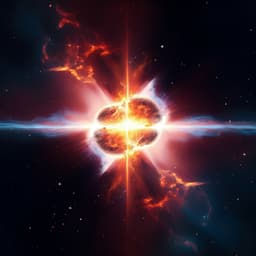
Space Sciences
Heavy-element production in a compact object merger observed by JWST
A. J. Levan, B. P. Gompertz, et al.
Explore the remarkable findings of GRB 230307A, an incredibly bright gamma-ray burst, as observed by the James Webb Space Telescope. This research, conducted by a collaborative team of experts, uncovers the production of r-process elements essential for heavy-element nucleosynthesis, helping us understand the universe's origins in greater depth.
~3 min • Beginner • English
Introduction
The study investigates whether some long-duration gamma-ray bursts originate from compact object mergers and whether such mergers synthesize heavy r-process elements. GRB 230307A, one of the brightest GRBs ever detected, provides a test case to examine the nature of its progenitor and the composition of its ejecta via multiwavelength follow-up. The purpose is to determine if the event exhibits a kilonova signature analogous to AT2017gfo (GW170817) and to identify specific heavy elements produced, thereby assessing the role of GRB-associated mergers in cosmic heavy-element nucleosynthesis. The broader significance lies in connecting GRBs, gravitational-wave sources, and r-process element production, and in evaluating how GRB observations complement GW detections for discovering kilonovae across cosmological distances.
Literature Review
The paper situates GRB 230307A within a growing set of long GRBs linked to compact object mergers, notably GRB 211211A, which also showed a kilonova. The canonical kilonova AT2017gfo following GW170817 established mergers as r-process factories and provided mid-infrared color and spectral benchmarks. Additional long GRBs suggested to arise from mergers include GRB 060614, GRB 110805A, and GRB 191019A. Prior work has shown late-time infrared excesses and spectral features consistent with heavy-element line emission in merger ejecta, and kilonova detections have been enabled by both electromagnetic and gravitational-wave triggers. The paper references how prompt-to-afterglow fluence ratios and hard-to-soft gamma-ray evolution can help differentiate merger-origin long GRBs from collapsar-origin GRBs. It also notes theoretical models involving synchrotron prompt emission with moving spectral breaks and numerical simulations exploring post-merger dynamics that might produce extended prompt emission durations.
Methodology
- High-energy detection: GRB 230307A was detected by Fermi/GBM and GECAM at 15:44:06 UT on 7 March 2023, with additional detections by several other high-energy instruments enabling an InterPlanetary Network (IPN) triangulation. Swift observations refined the localization and identified a candidate X-ray afterglow.
- Early optical/IR follow-up: Optical observations with ULTRACAM on the NTT detected the optical afterglow at the IPN/Swift location. Ground-based follow-up included Gemini South and VLT in optical/near-IR, Swift/XRT and Chandra in X-rays, and radio follow-up with ATCA and MeerKAT. MUSE integral field spectroscopy characterized nearby galaxies.
- JWST observations: Triggered by early indications of a red counterpart, JWST observations were obtained. NIRCam imaging at approximately 28.5–29 days post-burst detected an extremely red source with F150W(AB) = 28.1 ± 0.12 mag and F444W(AB) = 26.4 ± 0.01 mag. A second JWST epoch was obtained later (also NIRSpec spectroscopy at about 29 and 61 days).
- Spectroscopy: JWST/NIRSpec spectroscopy covered 0.5–5.5 microns. The transient was strongly detected beyond ~2 microns and showed distinct spectral features, including a broad absorption near ~1.125 microns (as described) and an emission-like feature near about 2.15 microns in both epochs. Emission lines from a nearby background galaxy (z ≈ 3.7–3.87) were also present but spatially offset from the transient trace.
- Host association and redshift: Imaging shows the GRB position offset by 30.2 arcsec (38.9 kpc in projection) from a bright spiral galaxy, adopted as the host at z ≈ 0.065. A faint galaxy at z ≈ 3.7 within ~0.3 arcsec is deemed a chance alignment based on inconsistency of energetics and color evolution for a high-redshift origin.
- Photometric evolution: Comparison of multi-epoch photometry, including the JWST F444W band, showed rapid fading (~2.4 mag between epochs) and very red colors. These were compared to AT2017gfo (scaled to the same distance) and to kilonova model spectra to interpret the emission as lanthanide-rich ejecta.
- Spectral modeling/interpretation: The prompt gamma-ray spectrum is modeled as a double broken power law with two evolving spectral breaks, consistent with a synchrotron origin. The NIRSpec line near 2.15 microns is attributed to [Te III], with redder features compatible with [Se III] and [W III], indicating r-process nucleosynthesis across a range of atomic masses.
Key Findings
- GRB classification and brightness: GRB 230307A is among the brightest GRBs ever detected (second only to GRB 221009A), with T90 = 35 s and a 10–1,000 keV fluence/flux of (2.951 ± 0.004) × 10^−6 erg cm^−2. Despite its bright prompt emission, the afterglow is exceptionally faint when scaled by prompt fluence, placing it as an outlier among >1,000 Swift GRBs and consistent with properties of merger-driven GRBs.
- Kilonova detection: Multiwavelength evolution shows an early blue phase transitioning to a red component by ~1.4 days, with colors and decay dominated by a kilonova beyond ~2 days. JWST/NIRCam photometry revealed an extremely red source (F150W(AB) = 28.1 ± 0.12; F444W(AB) = 26.4 ± 0.01 at ~28.5–29 days) that faded rapidly by ~2.4 mag at later times, matching kilonova behavior and inconsistent with standard afterglow or supernova models.
- Spectroscopic identification of heavy elements: JWST/NIRSpec spectra at ~29 and ~61 days show a clear emission feature at about 2.15 microns, consistent with [Te III] (tellurium; A ≈ 130), and additional features compatible with [Se III] and [W III]. The spectrum is very red, indicating lanthanide-rich ejecta. The mid-IR colors and late-time emission resemble AT2017gfo (including agreement with Spitzer 4.5 μm behavior), strengthening the kilonova interpretation. The abstract also reports an emission line at 21.15 μm interpreted as tellurium.
- Host association: The counterpart lies 30.2 arcsec from a bright spiral galaxy; the projected offset corresponds to 38.9 kpc. The event is associated with a galaxy at z ≈ 0.065. A nearby faint galaxy at z ≈ 3.7–3.87 is considered unrelated.
- Prompt emission properties: The prompt spectrum shows strong hard-to-soft evolution resembling GRB 211211A, modeled by a double broken power law with two spectral breaks moving through the gamma-ray band, consistent with a synchrotron origin.
- Implications for population and multi-messenger astronomy: The presence of kilonovae in two of the most fluent Fermi GRBs suggests mergers may contribute substantially to the bright long-GRB population. Long GRBs from mergers can extend effective GW horizons when jointly detected, provide independent kilonova discovery channels without GW triggers, and, with JWST, enable kilonova detections beyond the current GW-detection volume.
Discussion
The observations demonstrate that at least some long-duration GRBs can originate from compact object mergers rather than collapsars. The exceptionally faint afterglow relative to prompt fluence, the red, rapidly fading counterpart, and the mid-IR spectral features collectively indicate a kilonova with lanthanide-rich ejecta. The identification of a near-IR emission feature consistent with [Te III] (and possible [Se III], [W III]) directly supports r-process nucleosynthesis producing elements across a broad mass range in these events. This aligns GRB 230307A with AT2017gfo-like kilonova behavior and strengthens the link between GRBs and heavy-element production. The association with a low-redshift host at z ≈ 0.065 and a large projected offset is consistent with merger scenarios. These findings imply that mergers may represent a significant fraction of bright, long-duration GRBs. Consequently, GRB detections can complement gravitational-wave observations by providing extended reach and precise localizations, facilitating the discovery and study of kilonovae across greater cosmological volumes. A key open issue remains the long prompt emission duration in a merger context; proposed explanations involve central engine scenarios (e.g., magnetar formation, black hole–neutron star mergers) and post-merger accretion dynamics seen in simulations, but further work is required to reconcile the observed timescales.
Conclusion
The paper presents multi-epoch JWST imaging and spectroscopy of GRB 230307A, revealing a red, rapidly fading kilonova analogous to AT2017gfo and exhibiting near-IR spectral features consistent with r-process elements (notably tellurium). The event’s prompt and afterglow properties, host association at z ≈ 0.065, and spectral signatures support a compact object merger origin and demonstrate that such mergers can synthesize heavy elements across a wide mass range. This strengthens the case that some long-duration GRBs are merger-driven and highlights the role of GRB observations, together with JWST, in discovering kilonovae beyond current GW detector horizons. Future work should target: coordinated GRB–GW searches to expand multi-messenger samples; systematic JWST follow-up of bright GRBs to uncover kilonovae and measure elemental yields; and theoretical/numerical studies to explain extended prompt durations in merger scenarios and to refine spectral line identifications in the near- to mid-IR.
Limitations
- Temporal coverage is limited to two JWST spectroscopic epochs (~29 and ~61 days) and sparse earlier photometry, which may miss spectral/temporal evolution and additional lines.
- Line identifications (e.g., [Te III], [Se III], [W III]) rely on model comparisons and carry uncertainties in line blending and ejecta conditions.
- The origin of the long prompt duration remains unresolved; several progenitor/engine models could explain it, introducing interpretive degeneracy.
- Field confusion with nearby background galaxies required careful association; while the host is assigned at z ≈ 0.065, background alignments complicate interpretation in crowded fields.
Related Publications
Explore these studies to deepen your understanding of the subject.







